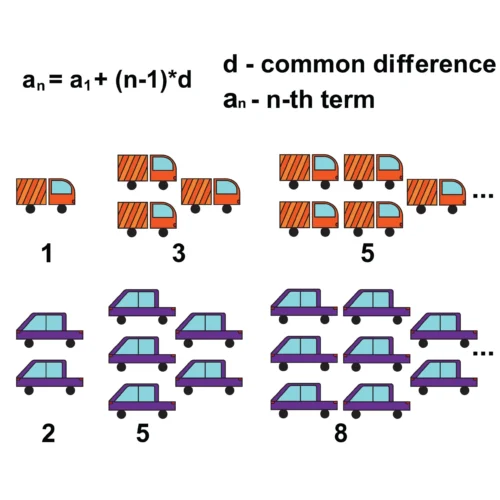Arithmetic Sequence

Table of Contents
What is Arithmetic Sequence?
An arithmetic sequence, also known as an arithmetic progression, is a series of numbers in which each term after the first is obtained by adding a constant value, referred to as the common difference, to the preceding term. The nature of this sequence is linear, and the common difference can be positive, negative, or zero, leading to different types of sequences:
Positive Common Difference: The sequence increases at a steady rate. For example, in the sequence 2, 4, 6, 8, …, the common difference is 2, and each term is 2 units larger than the previous one.
Negative Common Difference: The sequence decreases at a steady rate. For instance, in the sequence 10, 7, 4, 1, …, the common difference is -3, and each term is 3 units less than the previous one.
Zero Common Difference: The sequence remains constant. For example, in the sequence 5, 5, 5, 5, …, the common difference is 0, and all terms are the same.
How Arithmetic Sequence is Used
Financial Planning:
- Arithmetic sequences are used in financial planning and investment analysis. For example, if someone invests a certain amount of money each month in a savings account or retirement fund, the total amount at the end of each month forms an arithmetic sequence.
Mortgage Payments:
- Mortgage payments often follow an arithmetic sequence. The monthly payments are typically fixed and include both principal and interest. The remaining principal decreases constantly each month while the interest paid decreases gradually.
Salary Increases:
- In many professions, salary increases follow an arithmetic sequence. For instance, an employee may receive an annual raise of a fixed amount or percentage. The total salary over time forms an arithmetic sequence.
Sports and Athletics:
- Athletic performances, such as running times or swimming laps, can be modeled using arithmetic sequences. For example, if athletes improve their performance by a constant amount each week, their times form an arithmetic sequence.
Utility Bills:
- Utility bills, such as electricity or water bills, can follow an arithmetic sequence if the rates are constant. For instance, if the monthly cost per unit remains the same, the total bill forms an arithmetic sequence.
Solving Arithmetic Sequence
The general form of an arithmetic sequence is represented as: a,(a+d),(a+2d),(a+3d),…
In this sequence:
- a is the first term,
- d is the common difference between terms.
The formula for the n-th term (an) of an arithmetic sequence is given by:
a_n=a+(n-1)d
The formula for the sum of the first n terms (S_n) in an arithmetic sequence is given by:
S_n=\frac{n}{2}
(2a+(n-1)d)
Arithmetic Sequence Examples
Finding the n-th Term
Given ( a=2 ) and ( d=3 ), find the 6th term ( a_6 ) of the arithmetic sequence:
a_n=a+(n-1))d
a_6 = 2 + (6-1) \times 3 = 17
Finding the Common Difference
Given ( a_3 = 12 ) \text{ and } ( a_7 = 24 ), find the common difference ( d ) in the arithmetic sequence:
d = \frac{a_7 – a_3}{7 – 3} = 3
Related Links
Arithmetic Mean
Constant
Monomial
Terms